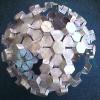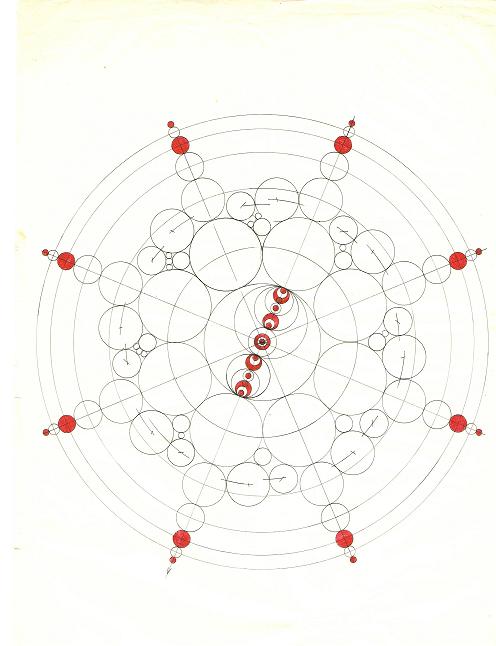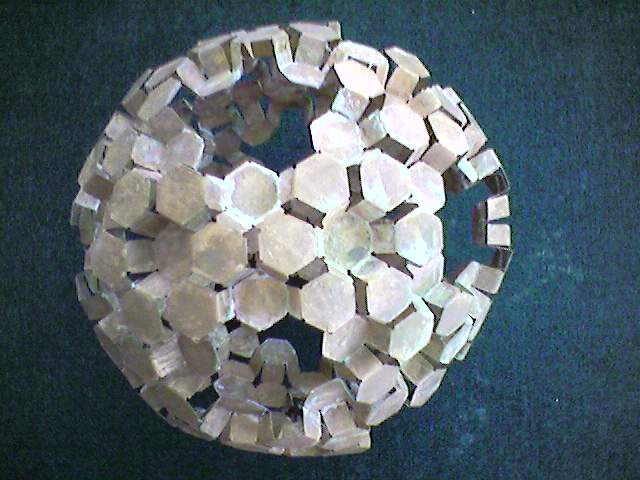-
Posts
26 -
Joined
-
Last visited
About bobhexa
- Birthday 12/01/1946
Profile Information
-
Location
Hawaii, Oahu, Manoa Valley
-
Interests
Invention, Geometry, 3-cushion, Eight Ball, Backgammon
-
College Major/Degree
Aero Engineering
-
Favorite Area of Science
Aerospace, Bio Engineering
-
Biography
English (Geordie) Serendipitist.Traveller
-
Occupation
Carpenter Musician Sculptor
Retained
- Quark
bobhexa's Achievements

Quark (2/13)
10
Reputation
-
Nearest hit to date to find the closest proximity to finding where Mother Nature uses this : The Norwalk Virus http://www.sandforsk.se/sandforsk-articles/index-article.htm Enamoured by these immortal words of Pioneer, I believe that we can use this design to build a capsid at nanoscale using DNA techniques which can then be prepacked with medication when in a flexed compact mode and unflexed to discharge meds to viral locations. The Nano boys can now do this Room for thought Gentlemen.
-
Dear cjohnso0 Hi Aloha and thank you for your reply. The Kenneth MacLean site is a golden referral...I must buy his book. I was with you all the way through to the finding the length of the side of the cube. It was at that point I got lost but I realised :doh:that the diagonal of that cube coincides with the diametrically opposed spheres of my model dodecahedron.(see earlier Attachment) And then as you say subtract from this diagonal length twice the radius of the balls, or 100mm . Does that give us the same answer? Thanks again
-
Is my description too ambiguous or is this a really difficult computation. I would be so grateful if somebody would please try to calculate this out. Aloha Bobhexa
-
In order to clarify I made up this model of 20 foam balls. They coincidentally fitted perfectly into this buckyball framework toy. Question....What would be the diameter of a sphere that fitted perfectly inside this model if the smaller surrounding spheres had a diameter of 100mm?
-
In the interim I have built a large model of a buckyball and obtained fairly precise measurements of the internal diameter...that is from the centres of the diametrically opposed hexagons. It would seem that the ratio of the diameter of the hexagon(flat to flat)to the inner sphere is certainly in the ballpark of the golden section. It is within hundredths of an inch. I am still wrestling with a method to calculate this mathematically. Any ideas Gentlemen. Mele Kalikimaka to all.
-
My attached diagram doesnt seem to be valid so I shall upload the image again. Using the C60 Buckyball as a reference, I joined 20 polystyrene foam balls together with toothpicks. In other words each of the twenty hexagons of the C60 were replaced with spheres. Surprisingly the overall appearance is of a pentagonal dodecahedron. Could it be that the truncated icosahedron can also be described as a truncated pentagonal dodecahedron? Could somebody please work out the math as to what the diameter of the inner sphere might be if the smaller surrounding spheres had a diameter of 100mm. Thanks in anticipation.
-
I thoroughly enjoyed your reference to Thomas Hales .Tis a very good informative piece of work. Absdorbing reading. I gradually understood that he was talking mainly about similar sized circles or similar sized spheres. My , I think, bottom line question is as follows. Supposing that you have a single sphere of 100 mm diameter and you have a plurality of smaller spheres with a diameter of only 62 mm (Golden Section ratio).....are you able to to distribute the smaller spheres around the surface area of the larger sphere and maintain perfect contacts between all neighbouring spheres. Is it a perfect fit? Having pondered this, I am led to the conclusion that a c60 pattern is the answer.You guys are the mathematicians. Do the ratios of the diameters of the larger sphere and the diameter of the 20 smaller spheres come anywhere close to the golden section ratio?
-
[ATTACH]1664[/ATTACH] As a practising geometist I was intrigued by the attached diagram which I drew a long while ago. I endevoured to draw eight circles around a larger circle so that all the circumferences touched. By rough measurement it appeared that the ratio of the diameters of the smaller circles to the diameter of the larger centre circle was very close to the Golden Section. A good friend and mathematician advised me that it was close but no coconuts were to be won. Well I have since wondered about the fact that it was so close. I have expanded my wondering to go 3 dimensional and to consider spheres instead of circles. So the question is gentlemen would spheres which are manufactured to have their diameters exactly a golden section ratio of the central sphere be able to pack around this central sphere and make an exact fit.
-
I hoped that you bio-engineers would have recognised the spherical form of this geometry but alas alack a sphere does not do it. So as a last plea to you, I would like you to consider the planar geometry which is a lot easier to visualize. It looks somewhat similar to the Z line which is defined as any of the dark thin protein bands to which actin filaments are attached in a striated muscle fiber and that mark the boundaries of adjoining contractile units. Please check this link. http://www.createthefuturecontest.com/pages/view/entriesdetail.html?entryID=875
-
Rhombic dodecahedrons..........compressed spheres .....what shape would a big bang make and what would it geometrically generate in 3d space? Just like soap bubbles.......lots of RD's.(All things being equal). The most elegant geometries generally encompass the Golden Section ratio. Does anyone know of a G.S. inherent in the RD? Is there a relationship between a RD and the placement of the twelve pentagons of a C60?(truncated icosahedron) How many degrees of freedom are there in a RD? You know , if the caveman who was the initial twerp who sat in the river mud and fashioned an orthogonal brick that unfortunately caught on in popularity for dwellings....well if only.............. he had sat there a litlle longer and had discovered the RD.....we would have had a far better and greater understanding of our planet energy with a far more interesting architecture to work from.
-
A very interesting viewpoint Pioneer You say that “ Potential can be stored into a stable configuration. This makes it easier, later on, for the virus to shed its protein shell and release the DNA.” Consider then, could it be that the concertina geometry of this sphere is ‘stored potential’? When internal pushes come to a shove, the double skinned sphere will gradually expand outward into a single skinned angular truncated icosahedron. During this process of expansion the 12 pentagonal openings get larger in diameter. Could this be an unknown mechanism allowing it to ‘shed its protein shell and release the DNA’ Do either of the views(last post), in any way or form, appear capsoidal? If it were so, it would need to be in an immature state of development, prior to shedding. Custers last stand hasn't got a look-in!!!!!
-
-
Okay, I accept that, based upon the lack of replies from my posting of the image that it does not interest you bio-engineer guys. That is okay as I had originally posted that this exercise is for the sake of getting the concept out into the knowledge bank as I really do consider that this geometry has some important application somewhere in engineering. I tried you guys first! It must exist somewhere in nature ...perhaps it is a foolhardy belief of mine that if something is elegant and efficient that it will have already been utilised by Mother Nature. Perhaps I am naive.... Nanoworld next stop....medical stent perhaps.





